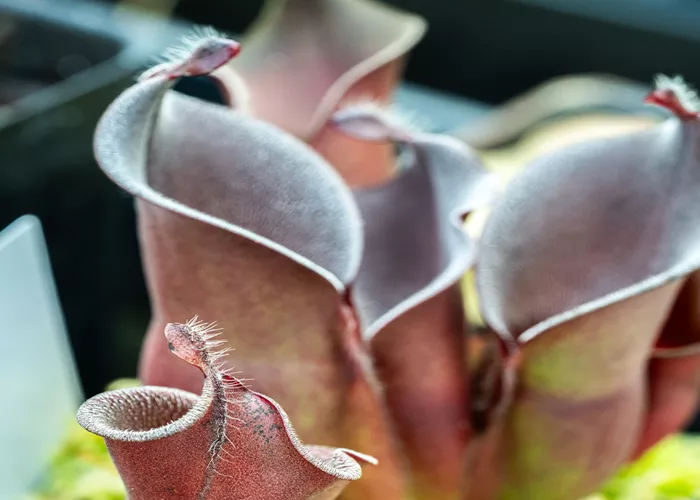While a jack-o’-lantern may seem like the scariest use of a pumpkin, the world is home to far stranger plants lurking in jungles and swamps. Fortunately, you don’t need to trek through hazardous terrain to find these unique organisms. A simple walk through the crisp autumn air can lead you to some fascinating botanical wonders at Michigan State University’s Plant Biology Conservatory and Herbarium.
Corpse Flower
The corpse flower, or Amorphophallus titanum, is a towering plant known for its foul odor, resembling that of rotting flesh. Native to the jungles of Sumatra, Indonesia, it features the largest flower head in the world and a massive corm, which is a root-like storage organ. Its burgundy spathe and prominent yellow spadix work together to emit a strong smell that attracts flies and carrion beetles, its primary pollinators.
Although this flower has bloomed only a few times in the past two decades, the last bloom at MSU in 2014 attracted over 3,000 visitors, all eager to witness this unusual spectacle.
Carrion Flower
Another intriguing plant is the carrion flower, part of the genus Stapelia. With a shape reminiscent of a starfish and the infamous Demogorgon from Stranger Things, these flowers also emit a foul odor to attract flies. Their thick petals, marked with red and white striations, mimic the appearance of rotting meat, effectively drawing in pollinators, including flesh flies, which sometimes lay eggs that hatch into maggots.
This is certainly not the kind of plant-based meat alternative you’d want in your kitchen.
Cup of Gold
The Cup of Gold, or Solandra, has a backstory that could fit right into a movie plot. Named after the legendary Holy Grail, this plant has a native range from central Mexico to South America and is known for its toxic properties. The large, pale-yellow flowers open mainly at night, attracting bats as their preferred pollinators. Historically, some have used this plant as a hallucinogen, often with deadly consequences.
Belladonna
Known for its toxicity, belladonna (Atropa belladonna) has a dark reputation. Named after Atropos, one of the Fates in Greek mythology, this plant is notorious for its potential as a poison, often used in tinctures and teas. Its ripe, enticing fruits, sometimes called devil’s cherries, can lead to accidental poisonings.
A specimen from MSU’s herbarium showcases a pressed branch of belladonna collected in 1816, highlighting its historical significance.
Pitcher Plants
Have you ever felt stuck in a nightmare where you can’t escape? That’s similar to the fate of unsuspecting insects that encounter pitcher plants. With over 100 known species, these carnivorous plants feature deep, nectar-filled cavities that lure prey inside. Once trapped, insects are slowly digested by the plant’s digestive juices.
The varied mechanisms of these plants, including slippery walls and hidden pools of water, create a treacherous environment for their victims, making them a perfect embodiment of nature’s trick-or-treat theme.
Staghorn Fern
Originating from the Pacific region, including Java, New Guinea, and Australia, the staghorn fern (Platycerium bifurcatum) is an epiphyte that grows on larger plants without harming them. These beautiful ferns have heart-shaped leaves that form a funnel, collecting organic matter like leaves and even small animals. This debris decomposes over time, providing nutrients for the fern—a fascinating, albeit eerie, cycle of life and death.
The Plant Biology Conservatory and MSU Herbarium welcome both the campus community and the public. Guided tours are available for those curious enough to explore these unsettling plants. Donations are also accepted to help sustain their collections, supporting education, outreach, and research in plant biology.
Related topics:
- Mastering the Art of Hardening Off Your Basil and Other Houseplants
- Last Chance to Plant Vibrant Spring Flowering Bulbs Like Tulips!
- Sign Up Now for the Exciting International Plant Trialing Conference!


